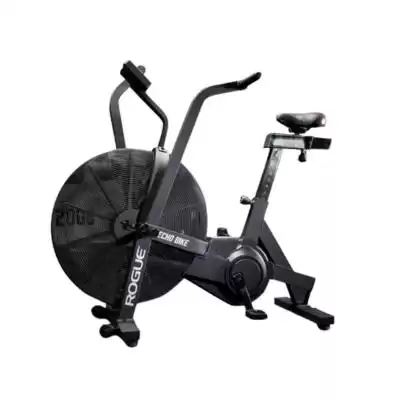The Rogue Echo is one of the most popular—if not the most popular—air bikes on the planet. And with good reason. In this review of the Rogue Echo Bike, I tested it for 100 days. Here’s what happened.
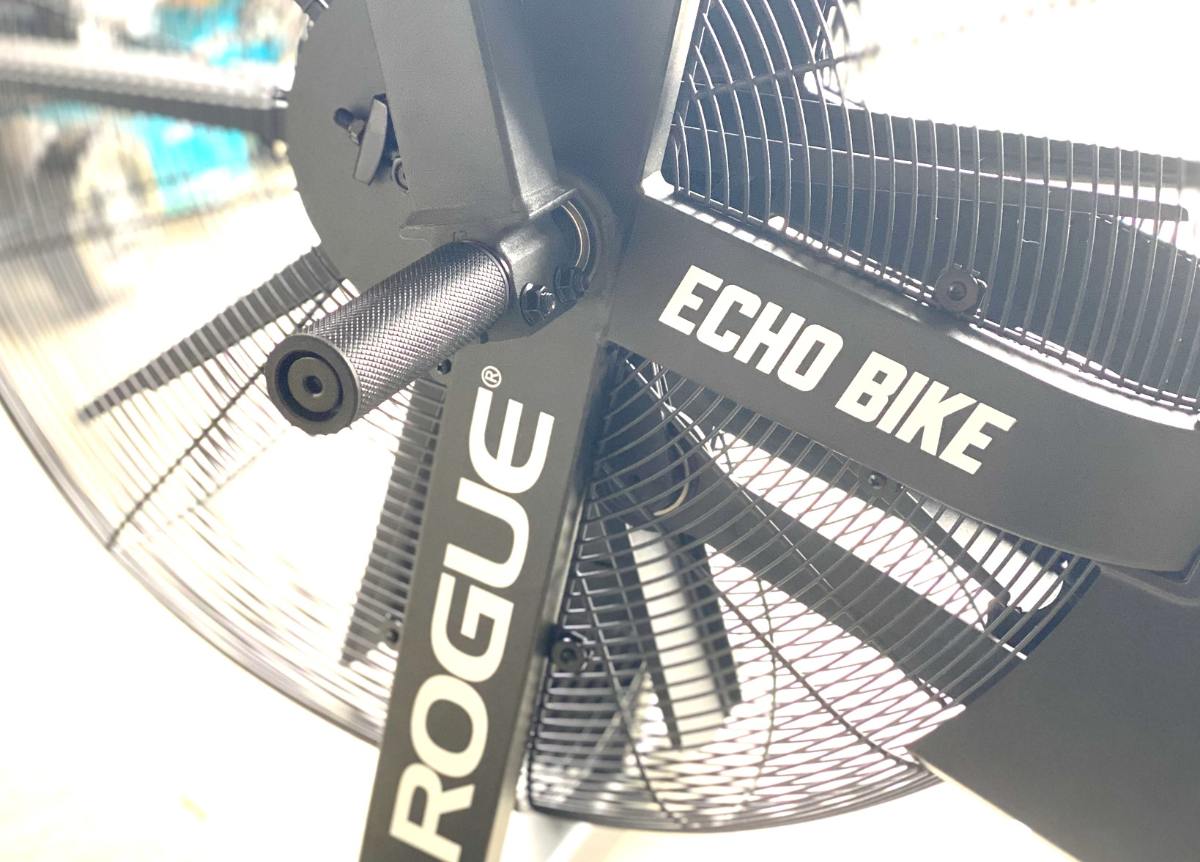
Rogue Fitness makes some of the best quality training and competition gear in the whole wide world.
Whether you are using their competition Olympic barbell or this absolute beast of a leg press machine, Rogue’s commitment to excellence and bomb-proof construction is obvious.
Assault bikes are a little trickier as they have a lot of moving parts. They require significantly more maintenance than a set of dumbbells or even a power rack.
Rogue’s Echo bike, which uses a belt-driven steel fan system, takes a lot of the maintenance and upkeep out of the equation, giving you an air bike that works like a monster and can be generally left to its own devices.
Here’s a deeper look at the Echo, what happened when I used it for 100 days in a row, how it compares to the other best air bikes on the market, and where you can pick up your own.
Let’s get right into it.
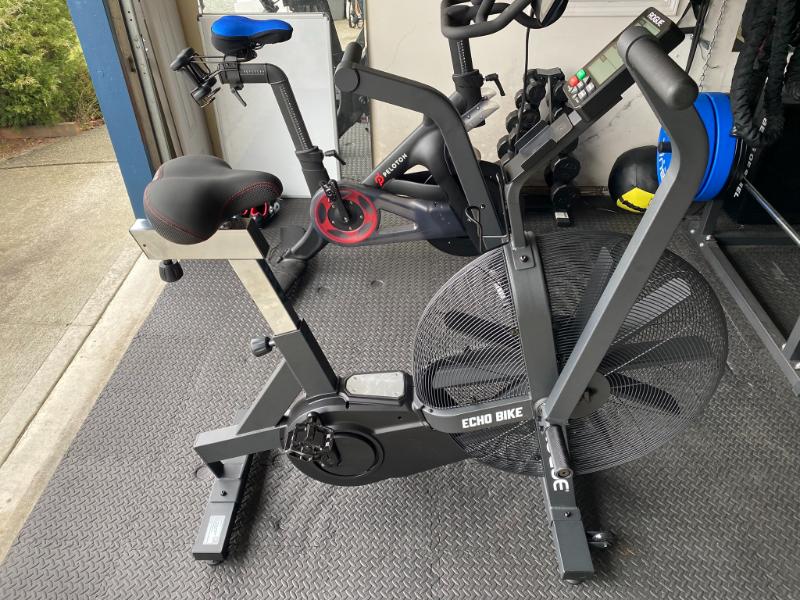
Key Features of the Rogue Echo Air Bike
Before we get into my experience using the Rogue Echo Bike (almost daily for the past three+ months), let’s take a quick look at the key features of the Echo.
They include:
✅ LCD display. Track your power output, time spent working out, and much more with the LCD display that can be customized to your training, whether it’s HIIT (my favorite workout on the Echo is blasting away rounds of Tabata) or slower-paced recovery work.
The display pairs with some of the more popular heart rate monitors (sold separately) like the Polar H10.
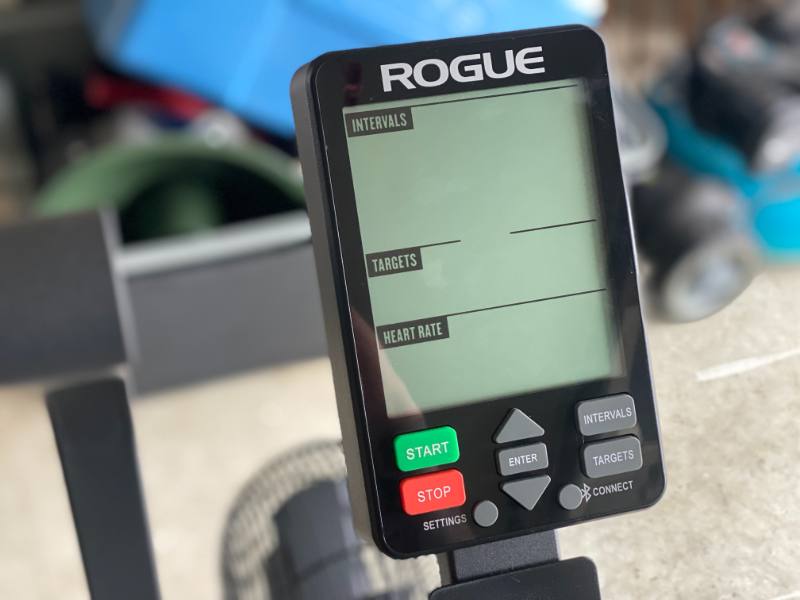
The Echo Bike is my favorite machine for HIIT workouts, and it will make an athlete out of you with all of the programming options in the LCD display.
(The Rogue Echo Bike V3 added Bluetooth connectivity, which means you can pair it with your heart rate monitor of choice.)
The only downside with the console is that it does not save your workouts, which is kind of a drag.
✅ Adjustable seat. I have a weird body—a long torso, long arms, short legs while also being tall. Sort of like a tall guerilla, which makes getting a good fit on a bike challenging.
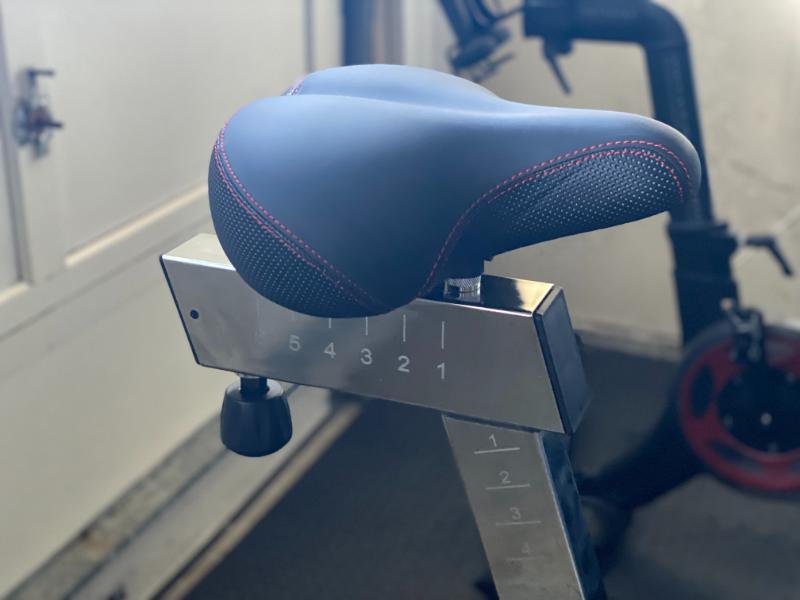
The Echo’s seat is adjustable up and down for a good, comfortable and custom riding experience.
Aim for a straighter leg (bring your butt up a little more towards the console compared to how you seat yourself on a stationary bike) when using the Echo Bike as you can drive more power into the pedals this way.
✅️ Long list of additional options. Tweak your Echo with a range of add-ons including a wind guard, a holder for your smartphone, and a water bottle cage (not compatible with larger 32oz water bottles like Nalgene or YETI).
✅ Rubber coated feet. The base of the Echo has rubber-coated feet and legs to keep the bike planted firmly on the ground and helps avoid sliding and rocking when working out.
✅ Metal fan and metal clips. The fan is made of steel—one of the few bikes that feature this—that spin smoothly.
The pedal clips are also full metal (you can select Shimano cleats as an add-on during the checkout process on Rogue’s website as well).
✅ Heaviest assault bike on the market. The Echo weighs a staggering 127lbs. Once set up, it’s not going anywhere. The wide footprint on the Echo also reduces wobbling while hammering away on the bike.
✅ Hot wheels. Under the fan are a pair of wheels that make moving the Echo a breeze (ha—see what I did there? Fan… breeze…good stuff, right?).
Wheel it out when it’s time to go to work, and wheel it back into the corner of your home gym when you are through.
✅ 2-year warranty. In the event of a defect or break, Rogue backs the Echo with a two-year warranty from the time of purchase.
My Experience with the Rogue Echo Bike
I’d been humming and hawing about buying the Rogue Echo Bike for our garage gym for around 12 months.
Partly because it was frequently out of stock during peak Covid, and also because my wife got a Peloton, and so it felt a little hard to justify having two cardio bikes at home.
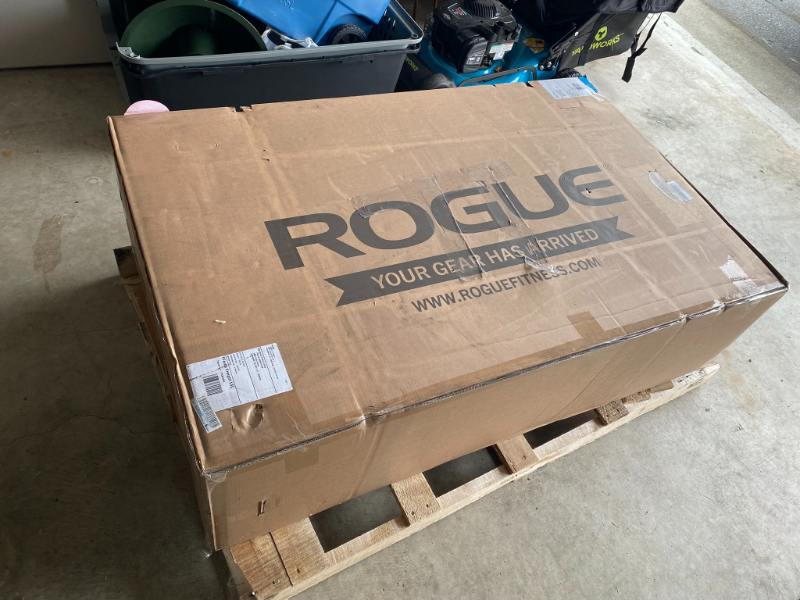
Eventually, I was able to convince myself that the Echo Bike would be a superior workout, so I hit “add to cart” on Rogue’s website.
After unboxing it, assembling it, and using it now for the last 100 out of 103 days (took three days off for our wedding anniversary), here’s a full report of my experience with the Echo Bike.
Assembly was an absolute breeze
I’ve put together more cardio and gym equipment than I care to remember, both commercial equipment and residential machines, and there have been some exceptionally memorable experiences along the way (i.e. throwing-wrenches-at-the-wall frustrating).
Putting together the Echo was… oddly enjoyable.
The assembly manual has six distinct steps, each very clearly detailed/explained. Tools were included. And the main part of the bike—the big steel fan, belt, and housing—arrives assembled.
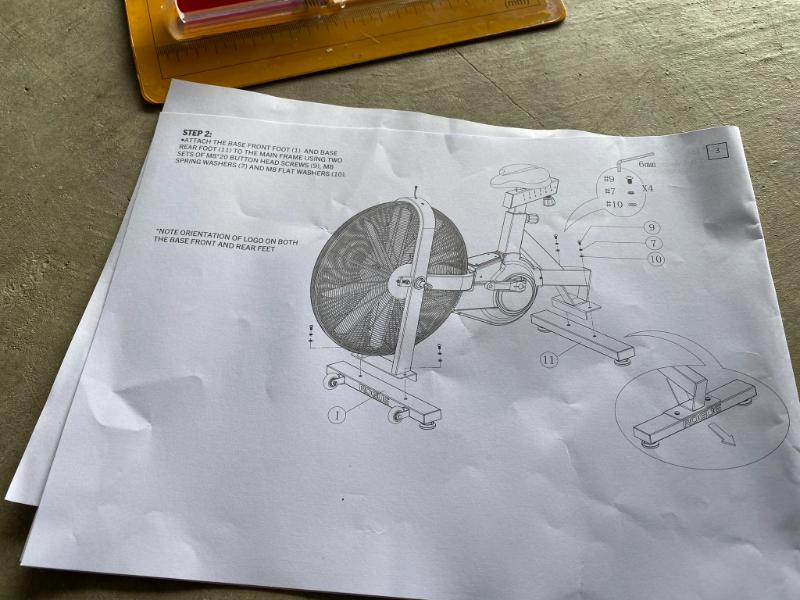
Perhaps it was the anticipation of using it that made it more fun, but I’d argue the simplified assembly process was the reason I actually enjoyed putting together the Echo Bike.
Assembly took about 30 minutes, but only because I was taking my sweet time.
Rides like a tank
The first impression of using the Echo Bike is that it is a tank. Make no bones about it; the Echo Bike is built for battle in every manner conceivable.
From the overall machine weight (at 127lbs it is significantly heavier than every other air bike on the market) to the belt drive, the Echo Bike rides smoothly.
I’m a larger guy, 6’4 and around 290lbs, and regularly go balls to the wall on the Echo, pushing 1,000 watts, and there is zero wobble or teetering.
No matter how hard I work (flail), the Echo just smiles back.
The smoothness of the Echo Bike is something that is difficult to describe, but it’s pretty awesome.
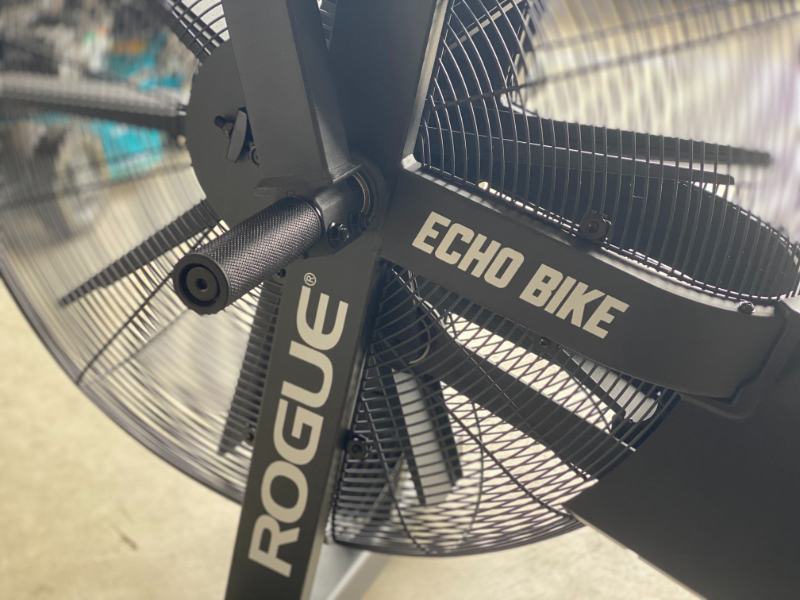
Superior build quality
Again, the Echo Bike is built at another level.
Having used countless machines over the years, you know a quality product when you use it, and even though the Echo Bike is built in China (unlike most of Rogue’s stuff, like their power racks and rigs, which are made in the USA using American and sometimes Canadian steel), you simply feel the quality of the bike when you get on it.
The price point of the Echo is reflected in the build quality.
More versatile for cardio than you think
Air bikes are difficult. There’s no doubt about that. They are called the “Devil’s Tricycle” for a reason.
Because they use air resistance, the lowest level of resistance is significantly harder compared to a stationary bike that has a true “zero” resistance level at its lowest levels.
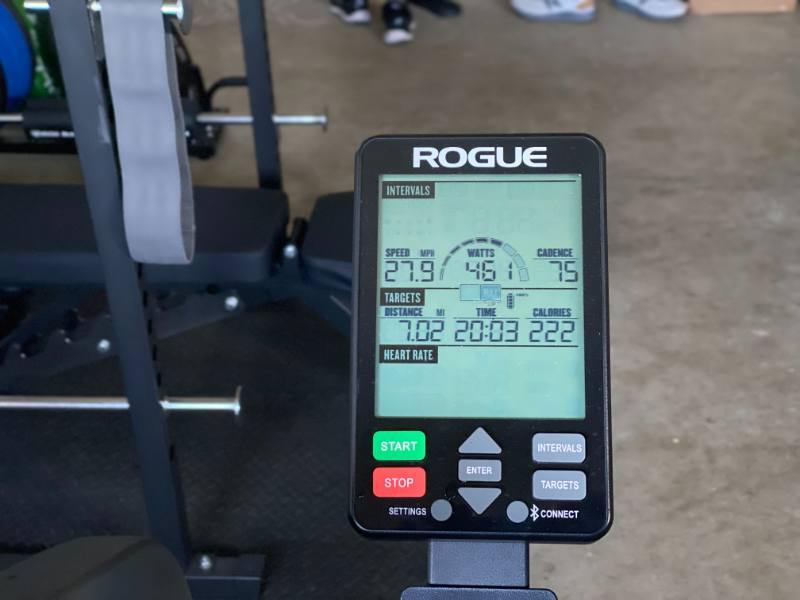
The higher starting level of resistance can cause the Echo to be put at the end of the line when it comes to lower-intensity cardio workouts.
But can you use the Echo Bike for longer, steady-state cardio workouts?
Absolutely.
While it’s most often used for HIIT workouts, I was able to get plenty of steady-state cardio workouts using the Echo bike.
Doing 35-45 minutes, heart rate not exceeding ~145 BPM, and hitting that fat-burning zone, is totally doable with the Echo.
Way more enjoyable than treadmills or bikes
Cardio workouts can be boring. We can all agree on that. Because of the simple LCD screen (i.e. no streaming or other distractions), the full body movement, and the increased difficulty of pushing air, the Echo Bike requires more focus.
Which is a good thing.
I find that Rogue Echo Bike workouts go faster than doing long steady-state cardio sessions on a stationary bike, where I usually spend most of the workout scrolling through my smartphone.
The big seat is comfortable
Skinny bike seats are hysterically uncomfortable. Spending longer than 15-20 minutes on the seats on a spin bike, for example, leaves my undercarriage feeling sore and often causes the area to go numb.
The seat on the Echo Bike is thick and wide (more cushion for the pushin’) and is comfortable even after 40-minute sessions on the bike.
Rogue Echo Bike – 100 Days Before and After
The main goal of the Rogue Echo Bike is improving health and fitness, whether that’s losing a few pounds, improving your VO2 max, building power, or just doing a different form of conditioning.
In my case, after three-and-a-half months of daily use, my resting heart rate lowered significantly, from an average of 50-52 BPM to a low of 45 BPM.
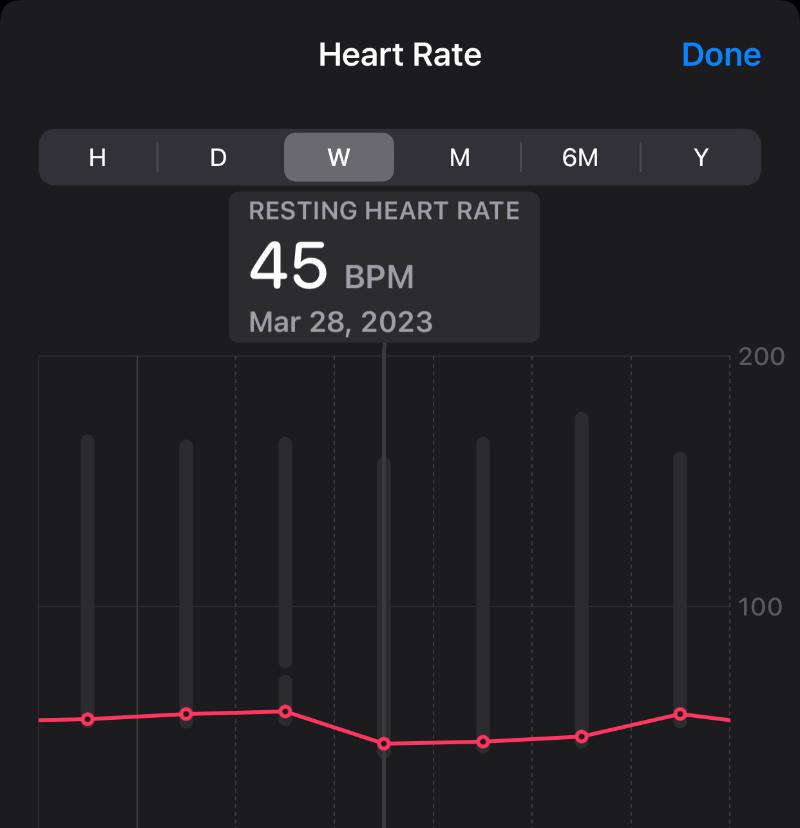
A fairly remarkable indicator of improvement in physical fitness, and to be honest, a larger improvement than I was expecting.
Fun Fact: Resting heart rate (RHR) is positively related with increased life expectancy1 and regular exercise is one of the best ways to improve RHR.
In terms of weight loss, there was some significant movement there too.
At the start of the 100 days I weighed in at 294lbs, and at the end, I was a much more lean 278lbs.
Great success!
It should be noted that during that span of time, nothing else changed. My diet was the same, weekend beers remained constant, and my existing workout schedule remained the same.
I simply bolted the daily Echo bike workout, ranging from 20-40 minutes, onto my regularly scheduled programming and saw some really excellent results.
Rogue Echo vs. AssaultBike Classic
The AssaultBike, made by Assault Fitness, was the first big assault bike on the scene. Nearly every gym across the country had one, and this was the bike of choice for most CrossFit competitions, including the Games.
Even though other bikes have come on the scene, including offerings from Bells of Steel, Schwinn Airdyne (the O.G. air bike), Concept 2, and of course Rogue, the AssaultBike remains popular.
The key difference between the Rogue Echo and the AssaultBike is the drivetrain.
The AssaultBike —like the Schwinn Airdyn Pro—uses a chain drive to create resistance. The Rogue Echo bike, on the other hand, uses a belt for the drivetrain.
Why does this difference matter?
Chain drives require frequent maintenance. Greasing, oiling, and of course, making sure that it stays on and is aligned properly.
The belt on the Rogue Echo is hands-off regarding proper tensioning and maintenance.
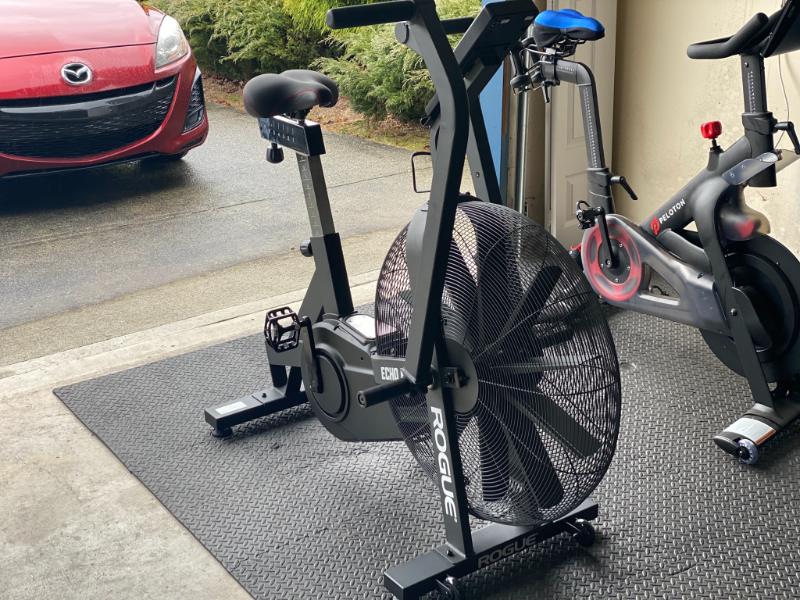
Compared to the AssaultBike, the Rogue Echo is also built like a total tank.
The Echo is beefier (50lbs heavier) and has a wider base, making it feel sturdier. Rogue makes tanks designed as fitness equipment, whether it’s their line of dumbbells or flat weight benches.
Rogue’s commitment to over-building is one of the reasons I love their stuff so much. Nobody wants to buy an expensive piece of fitness equipment and worry about durability.
Additionally, the Echo is one of the few assault bikes on the market that has a fan that is made completely of steel.
Price-wise, the Echo is in the same ballpark, retailing for $800 (check for current pricing and shipping options at Rogue’s website).
The additional cost balances out in the long run when you factor in the reduced maintenance and sturdier build.
Rogue Echo Bike — FAQs
How much does the Rogue Echo Bike weigh?
The Rogue Echo Bike weighs 127lbs, making it the heaviest air bike on the market.
In comparison, the Schwinn Airdyne 7 weighs 113lbs, the Bells of Steel Blitz weighs 120lbs, and the AssaultBike Pro weighs 118lbs.
The added weight of the Echo makes for a sturdier design and a less wobbly ride when in use.
Does the Rogue Echo bike come assembled?
The main part of the bike, including the belt drive, fan, and the main frame of the Rogue Echo Bike comes fully assembled.
There are several parts of the bike you will need to fasten and attach to the main frame of the bike.
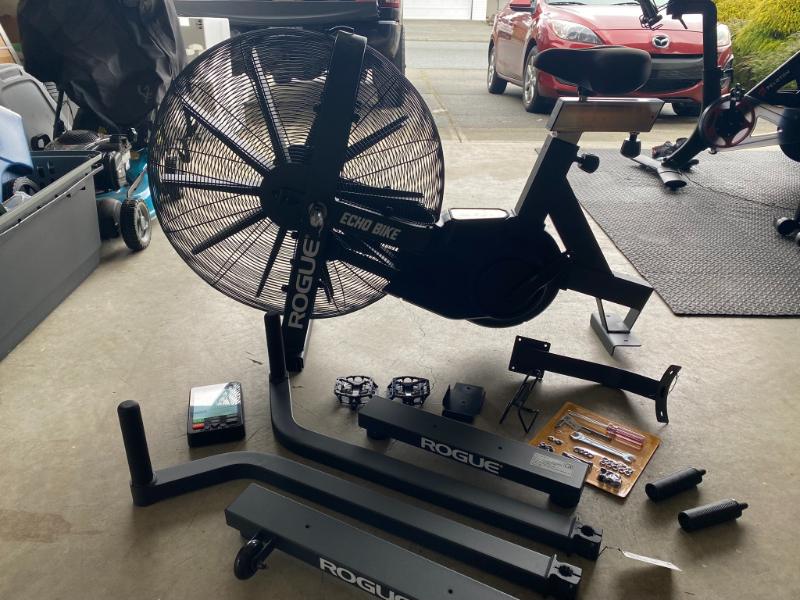
These include:
(1) Front and rear feet of the bike
(2) Console arm and LCD display
(3) Threading the pedals onto the frame
(4) The two handle arms, which are screwed into place by the foot pegs.
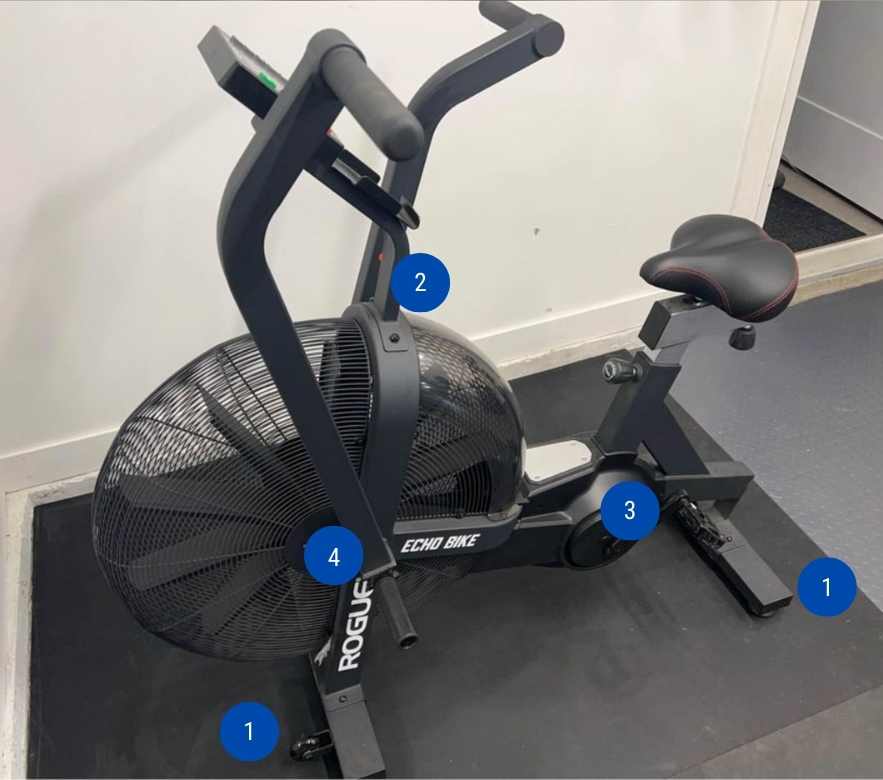
And that’s about it!
The seat handle, fan carriage, and belt drive arrive assembled.
Rogue also ships everything you will need to put together the bike—no additional tools are required.
How long does it take to assemble the Rogue echo bike?
It takes about thirty minutes to assemble the Rogue Echo.
Part of the assembly time is unpacking the bike, which is shipped bracketed in thick Styrofoam and wrapped with industrial-grade clear wrapping to prevent damage in traffic.
Tip: Make sure you firmly tighten the bolts on the arms of the Echo Bike. This is the reason the arms can feel like they are clunking or catching when in use.
The remainder is screwing in the components, including the front and rear foot stabilizers, threading the pedals, and installing the console and handle arms.
If you have experience putting together fitness equipment, you can probably do it faster than 30 minutes.
How loud is the Echo Bike?
The Rogue Echo Bike—and this goes for all air bikes—creates a lot of noise and vibration as they are pushing so much air around.
When pushing the pace on an Echo bike, expect the sound to be the equivalent to a large industrial fan (because that is essentially what is inside the wheel carriage on the bike).
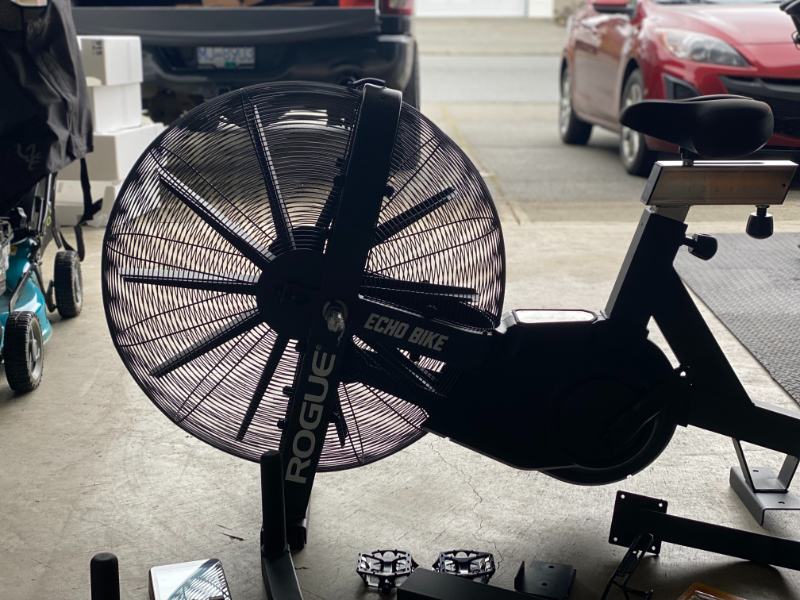
Although air bikes are generally loud, the Echo gets bonus points for utilizing a belt drive which is noticeably quieter compared to chain-drive bikes.
Is a Rogue Echo Bike worth it?
The Rogue Echo is an exceptional piece of training equipment. That said, it’s not inexpensive.
It retails for around ~$800, which can be pricey or simply not worth it for the more casual or recreational lifter or athlete.
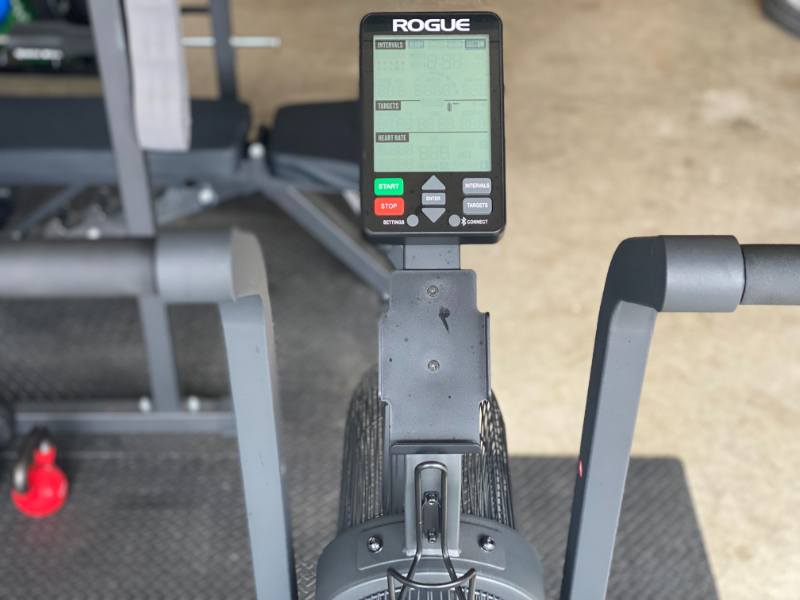
But for those serious about increasing their conditioning levels, burning a whole bunch of fat, and increasing athletic performance, the Echo Bike is simply the best-built option for training with an air bike.
Another thing to note when it comes to cost…
The Echo Bike holds its resale value really well.
I frequently catch Echo Bikes on Facebook marketplace selling for prices that match or even exceed retail.
What accessories should you get for the Rogue Echo Bike?
The Rogue Echo does not come with a wind guard, water bottle holder, or smartphone holder. I would highly recommend the wind guard for colder workout areas, as using the machine sends a blast of cold air straight up at your face.
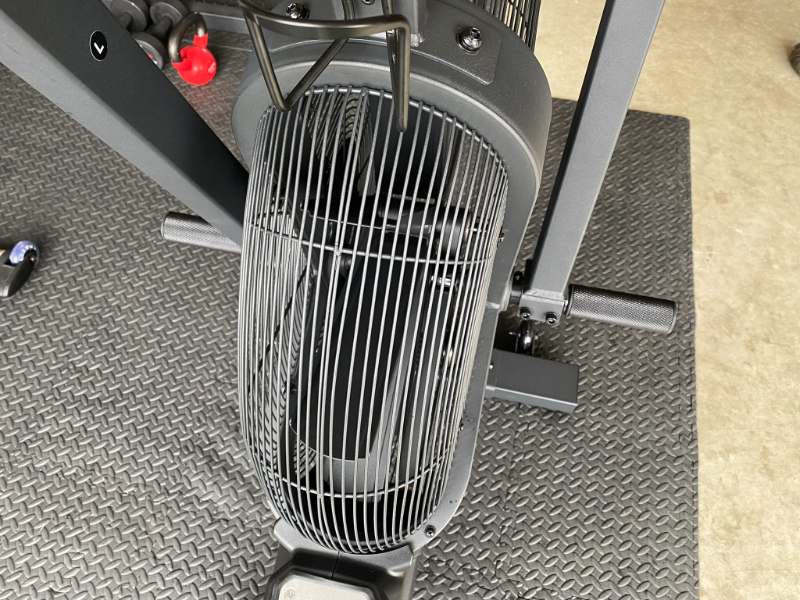
Once you get going, it’s kinda nice, but those first few minutes, especially when working out in a chilly garage, can be breezy and chilly without the wind guard.
Can using a Rogue Echo Bike make you stronger?
Yes. Especially when you use it for HIIT workouts. The Echo Bike, after all, is more of a low-RPM, strength-focused cardio machine that works both the upper and lower body.
A study1 took a group of people in their twenties and had them do 8-weeks of high-intensity workouts on an Echo Bike.
The intervals varied, including:
- 20x [:15 work, :45 rest]
- 25x [:20 work, :40 rest]
- 25x [:45 work, :15 rest]
The results at the end of the study showed that the Echo Bike increased back squat max, bench press, pulling strength, aerobic endurance, and peak VO2 max compared to the control group, who did medium-intensity runs on a treadmill.
How does a Rogue Echo Bike compare to a treadmill machine for building cardio?
The same study compared the anaerobic performance between the Echo Bike group and the control group, which performed 25-30 minutes of treadmill running (at 70% max heart rate) in place of the air bike workouts.
At the end of the 8-week testing period, the Echo Bike group generated significantly more anaerobic improvement compared to the treadmill group.
The Final Verdict
For most athletes and trainees, the Echo is a no-brainer.
Whether you are doing interval training or slow and steady cardio, it’s the best-built assault bike on the market, requires the least amount of maintenance, and will take all the punishment you can throw at it.
My only regret with the Rogue Echo Bike was not getting my hands on one sooner.
- Best overall air bike for home gyms
- Built like a tank
- Very simple assembly
- Console doesn't save workouts
More Air Bike Guides and Resources
The Best Air Bikes for Home Gyms (Unleash Beast Mode). Ready to perform a laser-targeted attack on your weight loss goals? Here’s a detailed look at the best Air Bikes for home gyms.
Air Bike vs Spin Bike: Pros, Cons and Differences. Curious about the differences between assault bikes and spin bikes? Here’s a detailed comparison, including pros, cons, and differences of both.
